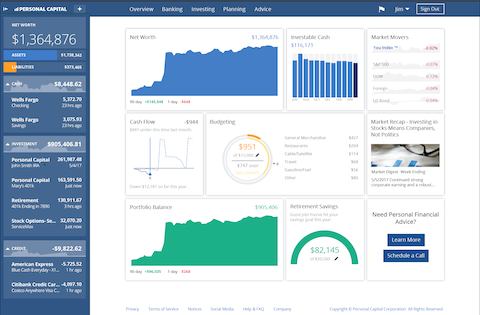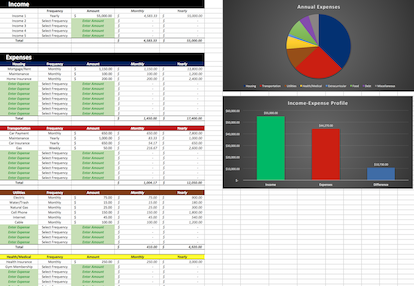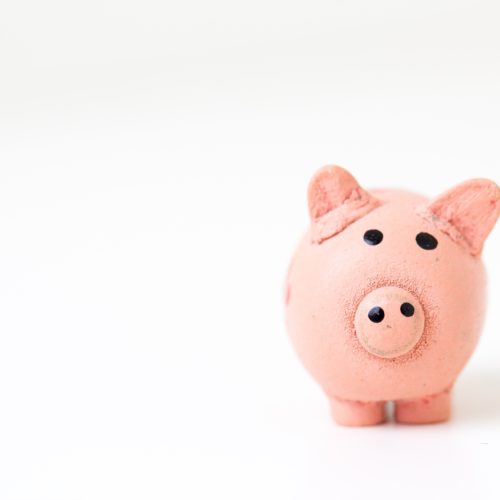
When you make the decision to become an early retiree, one of the first things you'll realize is that there are many, many different choices when it comes to investment accounts. 401(k), IRA, HSA, 457, 403(b), Roth, Taxable...the list can get pretty extensive. Each of these accounts has its own pros and cons and, depending on your unique situation in regard to taxes, timeframe, financial goals, or other factors, one may be more advantageous than another. However, for the majority of people, I believe there is a clear order in which you should prioritize the placement of your funds across your investment accounts. Assuming you have a fixed sum of money to invest (if you have an unlimited amount then you should fill them all up! Also, you should already be retired), here is the order in which you should invest it.
#1 401(k) (or 403(b) or 457 or equivalent plan) up to employer match
If your employer offers any kind of matching in your 401(k) plan, you should take immediate advantage. Simply put, investing in a 401(k) with an employer match is the best investment out there, period. The rate of matching may vary from company to company but most will offer something along the lines of, 50% match on all employee contributions, up to 6% of your total salary. That’s FREE MONEY! Deposit the funds into your account and, boom, instant raise. If the matching schedule for your 401(k) plan is a little less generous, don’t fret. As long as there’s some amount of matching, it’s almost always a great investment. Again, Free. Money. You’d be hard-pressed to find any other investment out there with a guaranteed, and instant return. But all that’s only half of the story. 401(k)s also allow you to defer paying taxes on whatever amount you contribute plus any gains, thus reducing your taxable income for the year! With a lower taxable income, your overall tax bill is reduced, which in turn, increases the amount of money you take home, giving you more funds to invest in item number 2! (2019 limit: $19,000; $25,000 for ages 50 and over)
#2 High-Interest Debt
Let’s say you had an investment opportunity available that would pay you 13% a year, guaranteed. That would be an amazing find worthy of further investigation, in most circumstances. But what if you also had some outstanding debt with an interest rate of 18%? Pursuing the investment opportunity, as great as it sounds, would end up costing you money. Your debt would continue to grow at 18% while your investment would be returning "only" 13%. All things being equal, you’d have a guaranteed net loss of 5% per year, as long as the debt remained unpaid. Clearly, this is a losing situation. Though not really an investment in the traditional sense of the word, paying off high-interest debt is still one of the most productive ways to use your money. Every dollar spent provides a guaranteed high rate of return and an instant savings of future funds. As can be gleaned from the above example, investing while retaining debt doesn't make much sense. As a result, paying off high-interest debt is the second best "investment" you can make.
#3 Health Savings Account (HSA)
Probably the least well-known account type on this list, an HSA can be a powerful tool for any aspiring early retiree. These accounts were designed as a tax-free method of paying for qualified medical expenses, however, there is no rule that forces you to use one in such a way. To get the most benefit out of your HSA, you should instead treat it as a normal investment account. So what makes the HSA attractive enough to be 3rd on this list? Taxes. This type of account has one of the most favorable tax treatments of any investment option. Similar to a 401(k), you pay zero income tax on all contributions. The HSA goes even further though. You also owe no FICA taxes (Social Security and Medicare taxes) on contributions (your contributions must be made via payroll deduction to take advantage of this benefit). These deductions reduce your taxable income by the amount of your contribution, thus reducing your tax bill and increasing your take-home pay. Later, when you’re ready to withdraw your funds, there are additional benefits. For example...
While you’re still employed, you could choose to pay all medical expenses out of pocket while still contributing to an HSA and allowing the funds to continuously grow. Over time, you'd save all receipts for the medical expenses incurred. As soon as you retire, you can submit all of those receipts to your HSA for cash money. You can do this no matter how old the receipts are, as long as you opened your HSA before the date of the expense. On top of that, the reimbursements will be 100% tax-free.
Another option is to use your HSA in early retirement for its intended purpose, to pay for medical expenses. You’ll be able to cover any qualified medical expense, tax-free. If you’re worried that you won’t have enough medical expenses throughout retirement to utilize all of the funds in your account, first, you should smile. That means you’ve lived a very healthy life! Second, you should stop worrying. Once you turn 65, you can withdraw funds from the account for any purpose at all (only medical expenditures remain tax-free, unfortunately)!
As you can see, the Health Savings Account, an extremely underrated investment account. (2019 limit: $3,500; $4,500 age 55 or older)
Note: An HSA is only available to someone who is enrolled in a high-deductible health plan (HDHP), so if you’re interested in obtaining one, pay close attention during your next annual health care enrollment period at work. You MUST be enrolled in an HDHP to utilize an HSA.
#4 Traditional IRA/Roth IRA
Traditional IRA versus Roth IRA. There are too many arguments to count proclaiming one or the other is the better investment. So which is actually the best investment for early retirement? The answer is, it depends.
All money in a Roth IRA is totally tax-free, forever. The problem is, you (usually) have to pay taxes on the money before you can get it into the account. Once you're in early (or late, or any) retirement, the more money you have in a Roth IRA, the better. While you're still employed, it’s not so clear. Contributing to a Traditional IRA allows you to deduct the contributions from your taxable income (as long as you meet the workplace retirement plan rules and income limits). As noted in the 401(k) breakdown, this deduction can provide a huge benefit. But is the benefit worth trapping all of your funds in an account until 59.5, when you'll be taxed on all withdrawals? Choosing between these two can be tough, but do not despair. I have an answer for you. Well, a few answers to be exact. Based on your circumstances, you should do one of the following:
If you meet all the requirements for eligibility to deduct your Traditional IRA contributions from your income, you should choose a Traditional IRA. The income deduction is simply too good to pass up. It may seem like you're gambling on a lower tax bracket in older age but in reality, you should have plenty of time before reaching the required minimum distribution age (70.5 years old in 2018) to convert your Traditional IRA funds into Roth funds (yep, you can do that), minimizing your tax liability. When it's all said and done, you could end up getting the best of both worlds.
If you find that you are ineligible to deduct Traditional IRA contributions, then go straight for a Roth IRA. That is, assuming you don't cross the Roth IRA income limit. If you make so much that you've crossed the Traditional IRA deduction limit and the Roth IRA contribution limit, congratulations on being so well compensated! There are few valid excuses for you not to retire veeeery early. If you are in this situation, there is still a way for you to take advantage of an IRA. You'll do it through what’s called "backdoor" Roth contributions. The gist is that you contribute non-deductible funds to a Traditional IRA and then perform a Roth conversion on the funds. Some argue over the appropriate timeline but I believe it's ok to do the conversion the very next day. (Kitces.com and IRAHelp.com have both written ultra-detailed articles on the topic, check them out to dig further into the details of the backdoor Roth IRA).
Don't forget to Check out the IRS website for the current income limits and other IRA eligibility guidelines. (2019 limit: $6,000; $7,00 for ages 50 and over)
Note: The tax advantages of traditional accounts begin to fade at lower levels of income. If your income is currently at the lower end of the spectrum a Roth IRA could be right for you. Be sure to run your own numbers (use the examples here) before making your final decision.
#5 401(k) up to yearly max
Once you’ve fully funded your HSA and IRA, it's time to return to the best overall investment around. We’ve already gone over many of the benefits of a 401(k) so there’s not much to add here. You’ve contributed enough to get the full match from your employer, now all that’s left is to work towards maxing out your contribution to take advantage of the compounding tax savings i.e. increased 401(k) contribution = reduced taxable income = lower tax liability = increased money in pocket = even more funds to invest. (2019 limit: $19,000; $25,000 for ages 50 and over)
#6 Taxable Investment Account
If you have access to any of the accounts above, you should already have several thousand dollars invested before you even begin considering opening a taxable investment account. For those that have managed to max out all of the accounts up to this point (and pay off all high-interest debt), give yourself a pat on the back. You are well on your way to a very early retirement. However, if your circumstances have prevented you from taking advantage of one or more of the accounts but you still have money you'd like to invest, you're in luck. Taxable accounts have no rules on who can contribute or how much they can deposit (well...very few rules at least). They also have several unique benefits that some of the other accounts don't offer.
With a taxable account, you can invest in just about anything. So whatever security you're interested in, you'll most likely be able to find a taxable account to purchase it through. In addition, any losses you experience in a taxable account can be deducted when you file your taxes (up to $3,000 per year in 2018; you can carry over any additional losses to future years). Finally, any long-term (1 year or more) capital gains you capture are taxed at 0%, 15%, or 20%, depending on your tax bracket. In early retirement, this tax treatment can be EXTREMELY beneficial. In fact, by properly leveraging this rule, you could potentially avoid paying all income taxes in retirement. But that's a story for a future article... (limit: Unlimited)
#7 After-Tax 401(k) contributions
Taxable investment accounts have no spending cap so, in theory, you could skip after-tax 401(k) contributions--not to be confused with Roth contributions--and put everything into a taxable account (after taking full advantage of items 1 through 5 of course). There are some benefits to after-tax 401(k) contributions, however. One of the advantages is that contributions usually happen automatically, via automatic deductions by your employer. This means you never see the money and so it’s impossible to be tempted to spend it. Another advantage is that all gains are tax-deferred just like the rest of your 401(k) savings. Last, and perhaps most beneficial, once you leave your job, you can roll over your after-tax 401(k) contributions directly into a Roth IRA. So every dollar you contribute while employed is actually a future contribution to your Roth IRA. (2019 limit: $56,000; $62,000 for ages 50 and over)
Before You Begin
Before allocating any money to investing, you should first consider establishing a solid emergency fund. If you don't have at least $1,000 in the bank (in a high-yield savings account) you should focus on saving before attempting to invest. Once you have $1,000 or more saved, you can slowly begin investing. Start with the top two items on our list. Invest enough to get the employer match in your 401(k) and work on eliminating high-interest debt. I'd advise against pursuing any additional investments outside of these two until you've fully funded your emergency fund. I recommend having at least 3, and no more than 12, months’ worth of living expenses saved for a complete emergency fund.
Final Thoughts
There you have it! The Official GGD Early Retirement Investment Account Hierarchy. Start at the top and move to the bottom, filling each account with funds along the way.
Tools To Get You Started
Get a head start on your journey toward achieving financial independence by analyzing and tracking your income, expenses, investment performance, and overall net worth with the free online wealth management tool Personal Capital.
We use Personal Capital regularly to analyze our investment fees, track our investments, and project our net worth. We also periodically review our progress toward retirement with their retirement planning calculator.
If you’d rather do things on your own, become a subscriber today and you’ll receive our Free Financial Planning Dashboard. This tool allows you to enter your income and expenses to create a detailed budget. You can use it to track your spending habits over time or just to get an idea of where your money is going each month. Take a look at the automatically generated charts and you may discover you have a little more cash to invest than you thought.
If you’re interested in detailed instructions on how to budget, save, pay off debt, and invest, check out The 6 Phases of Building Wealth. This book provides step-by-step instructions for working through each “Phase” in the process of achieving Financial Freedom. If you're just starting out, the information in this book will provide you with an invaluable resource. You can pick up the digital version for only $2.99 on Amazon.
Disclosure: Some of the links found on this website may be affiliate links. Affiliate links pay GGD a small commission when you click through and/or make a purchase. This is at zero additional cost to you.
Full Disclaimer/Disclosure
Related Posts
-
The Simple Formula I’m Using To Retire In My 30's
Wake up, go to work, spend a few hours with family, go to bed, rinse and repeat. Some form of this routine probably describes the typical day for most of us. Throughout our lives, we’re…
-
Monthly Financial Update - February 1, 2018
The Monthly Financial Update gives our readers an inside look at the allocation and performance of our personal portfolio. At the beginning of each month, we share a snapshot of our investments and highlight their…
-
Why 401(k)s Are The Best Investments, Period
There are plenty of great investment options out there to choose from, but very few can compete with the advantages of a 401(k). When you add in employer matching to the equation, I believe 401(k)s…







Really helpful feature on HSAs! We just talked about these at my office and this gave me the push I need to go ahead and sign up, I think.
That’s Great, do it!